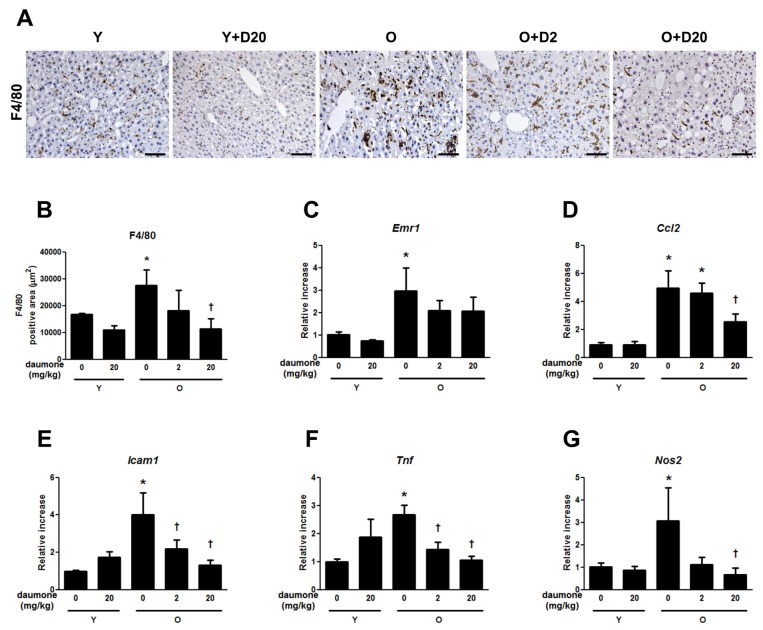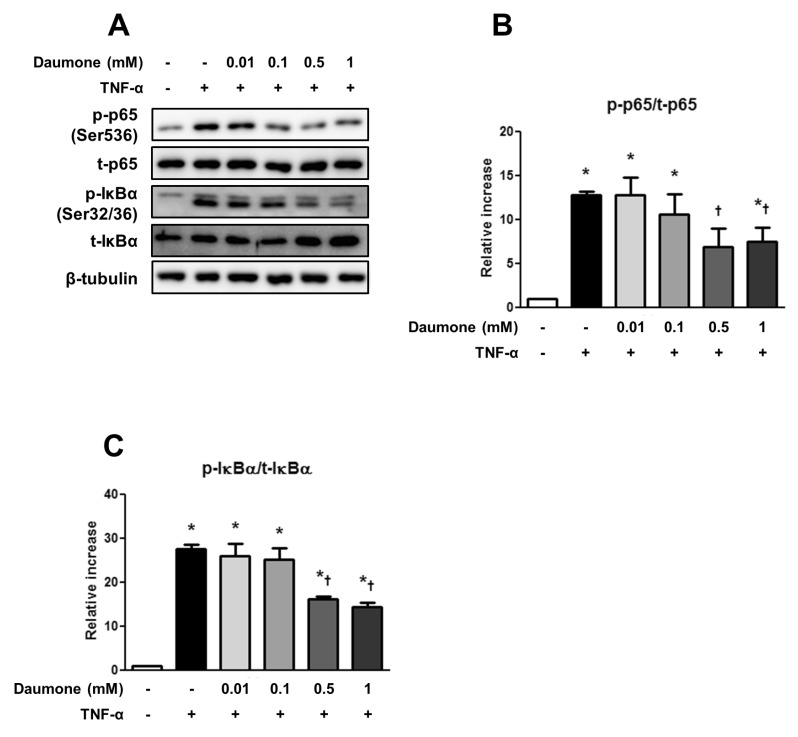Korean J Physiol Pharmacol.
2015 May;19(3):269-274. 10.4196/kjpp.2015.19.3.269.
Short-term Treatment of Daumone Improves Hepatic Inflammation in Aged Mice
- Affiliations
-
- 1Graduate School of Pharmaceutical Sciences, College of Pharmacy, Ewha Womans University, Seoul 120-750, Korea. hha@ewha.ac.kr
- KMID: 1791429
- DOI: http://doi.org/10.4196/kjpp.2015.19.3.269
Abstract
- Chronic inflammation has been proposed as one of the main molecular mechanisms of aging and age-related diseases. Although evidence in humans is limited, short-term calorie restriction (CR) has been shown to have anti-inflammatory effects in aged experimental animals. We reported on the long-term treatment of daumone, a synthetic pheromone secreted by Caenorhabditis elegans in an energy deficient environment, extends the life-span and attenuates liver injury in aged mice. The present study examined whether late onset short-term treatment of daumone exerts anti-inflammatory effects in the livers of aged mice. Daumone was administered orally at doses of 2 or 20 mg/kg/day for 5 weeks to 24-month-old male C57BL/6J mice. Increased liver macrophage infiltration and gene expression of proinflammatory cytokines in aged mice were significantly attenuated by daumone treatment, suggesting that short-term oral administration of daumone may have hepatoprotective effects. Daumone also dose-dependently suppressed tumor necrosis factor-alpha (TNF-alpha)-induced nuclear factor-kappaB (NF-kappaB) phosphorylation in HepG2 cells. The present data demonstrated that short-term treatment of daumone has anti-inflammatory effects in aged mouse livers possibly through suppression of NF-kappaB signaling and suggest that daumone may become a lead compound targeting aging and age-associated diseases.
Keyword
MeSH Terms
Figure
Cited by 1 articles
-
Carbon monoxide releasing molecule-2 protects mice against acute kidney injury through inhibition of ER stress
Md Jamal Uddin, Eun Seon Pak, Hunjoo Ha
Korean J Physiol Pharmacol. 2018;22(5):567-575. doi: 10.4196/kjpp.2018.22.5.567.
Reference
-
1. Bartke A, Wright JC, Mattison JA, Ingram DK, Miller RA, Roth GS. Extending the lifespan of long-lived mice. Nature. 2001; 414:412. PMID: 11719795.
Article2. Fontana L, Partridge L, Longo VD. Extending healthy life span--from yeast to humans. Science. 2010; 328:321–326. PMID: 20395504.
Article3. Cantó C, Auwerx J. Calorie restriction: is AMPK a key sensor and effector? Physiology (Bethesda). 2011; 26:214–224. PMID: 21841070.
Article4. Menzies KJ, Hood DA. The role of SirT1 in muscle mitochondrial turnover. Mitochondrion. 2012; 12:5–13. PMID: 21406254.
Article5. Harrison DE, Strong R, Sharp ZD, Nelson JF, Astle CM, Flurkey K, Nadon NL, Wilkinson JE, Frenkel K, Carter CS, Pahor M, Javors MA, Fernandez E, Miller RA. Rapamycin fed late in life extends lifespan in genetically heterogeneous mice. Nature. 2009; 460:392–395. PMID: 19587680.
Article6. Martin-Montalvo A, Mercken EM, Mitchell SJ, Palacios HH, Mote PL, Scheibye-Knudsen M, Gomes AP, Ward TM, Minor RK, Blouin MJ, Schwab M, Pollak M, Zhang Y, Yu Y, Becker KG, Bohr VA, Ingram DK, Sinclair DA, Wolf NS, Spindler SR, Bernier M, de Cabo R. Metformin improves healthspan and lifespan in mice. Nat Commun. 2013; 4:2192. PMID: 23900241.
Article7. Park JH, Chung HY, Kim M, Lee JH, Jung M, Ha H. Daumone fed late in life improves survival and reduces hepatic inflammation and fibrosis in mice. Aging Cell. 2014; 13:709–718. PMID: 24796965.
Article8. Hu PJ. Dauer. WormBook: The Online Review of C. elegans Biology. In : Riddle DL, editor. WormBook. United States: The C. elegans Research Community;2007. p. 1–19.9. Franceschi C, Capri M, Monti D, Giunta S, Olivieri F, Sevini F, Panourgia MP, Invidia L, Celani L, Scurti M, Cevenini E, Castellani GC, Salvioli S. Inflammaging and anti-inflammaging: a systemic perspective on aging and longevity emerged from studies in humans. Mech Ageing Dev. 2007; 128:92–105. PMID: 17116321.
Article10. Freund A, Orjalo AV, Desprez PY, Campisi J. Inflammatory networks during cellular senescence: causes and consequences. Trends Mol Med. 2010; 16:238–246. PMID: 20444648.
Article11. Chung HY, Cesari M, Anton S, Marzetti E, Giovannini S, Seo AY, Carter C, Yu BP, Leeuwenburgh C. Molecular inflammation: underpinnings of aging and age-related diseases. Ageing Res Rev. 2009; 8:18–30. PMID: 18692159.
Article12. Franceschi C, Bonafè M. Centenarians as a model for healthy aging. Biochem Soc Trans. 2003; 31:457–461. PMID: 12653662.
Article13. Chung HY, Sung B, Jung KJ, Zou Y, Yu BP. The molecular inflammatory process in aging. Antioxid Redox Signal. 2006; 8:572–581. PMID: 16677101.
Article14. Chung HY, Kim HJ, Kim JW, Yu BP. The inflammation hypothesis of aging: molecular modulation by calorie restriction. Ann N Y Acad Sci. 2001; 928:327–335. PMID: 11795524.15. Seo AY, Hofer T, Sung B, Judge S, Chung HY, Leeuwenburgh C. Hepatic oxidative stress during aging: effects of 8% long-term calorie restriction and lifelong exercise. Antioxid Redox Signal. 2006; 8:529–538. PMID: 16677097.
Article16. Hilmer SN, Cogger VC, Le Couteur DG. Basal activity of Kupffer cells increases with old age. J Gerontol A Biol Sci Med Sci. 2007; 62:973–978. PMID: 17895435.
Article17. Cao SX, Dhahbi JM, Mote PL, Spindler SR. Genomic profiling of short- and long-term caloric restriction effects in the liver of aging mice. Proc Natl Acad Sci U S A. 2001; 98:10630–10635. PMID: 11535822.
Article18. Jung KJ, Lee EK, Kim JY, Zou Y, Sung B, Heo HS, Kim MK, Lee J, Kim ND, Yu BP, Chung HY. Effect of short term calorie restriction on pro-inflammatory NF-kB and AP-1 in aged rat kidney. Inflamm Res. 2009; 58:143–150. PMID: 19199090.
Article19. Jeong PY, Jung M, Yim YH, Kim H, Park M, Hong E, Lee W, Kim YH, Kim K, Paik YK. Chemical structure and biological activity of the Caenorhabditis elegans dauer-inducing pheromone. Nature. 2005; 433:541–545. PMID: 15690045.
Article20. Goto S, Takahashi R, Araki S, Nakamoto H. Dietary restriction initiated in late adulthood can reverse age-related alterations of protein and protein metabolism. Ann N Y Acad Sci. 2002; 959:50–56. PMID: 11976185.
Article21. Wang C, Maddick M, Miwa S, Jurk D, Czapiewski R, Saretzki G, Langie SA, Godschalk RW, Cameron K, von Zglinicki T. Adult-onset, short-term dietary restriction reduces cell senescence in mice. Aging (Albany NY). 2010; 2:555–566. PMID: 20844316.
Article22. Weindruch R, Walford RL. Dietary restriction in mice beginning at 1 year of age: effect on life-span and spontaneous cancer incidence. Science. 1982; 215:1415–1418. PMID: 7063854.
Article23. Baffy G. Kupffer cells in non-alcoholic fatty liver disease: the emerging view. J Hepatol. 2009; 51:212–223. PMID: 19447517.
Article24. Wenfeng Z, Yakun W, Di M, Jianping G, Chuanxin W, Chun H. Kupffer cells: increasingly significant role in nonalcoholic fatty liver disease. Ann Hepatol. 2014; 13:489–495. PMID: 25152980.
Article25. Kanters E, Pasparakis M, Gijbels MJ, Vergouwe MN, Partouns-Hendriks I, Fijneman RJ, Clausen BE, Förster I, Kockx MM, Rajewsky K, Kraal G, Hofker MH, de Winther MP. Inhibition of NF-kappaB activation in macrophages increases atherosclerosis in LDL receptor-deficient mice. J Clin Invest. 2003; 112:1176–1185. PMID: 14561702.
- Full Text Links
- Actions
-
Cited
- CITED
-
- Close
- Share
- Similar articles
-
- Gamma-tocopherol ameliorates hyperglycemia-induced hepatic inflammation associated with NLRP3 inflammasome in alloxan-induced diabetic mice
- Inhibition of Serotonin Synthesis Induces Negative Hepatic Lipid Balance
- Impaired liver regeneration and lipid homeostasis in CCl4 treated WDR13 deficient mice
- Treadmill Exercise Improves Motor Function and Short-term Memory by Enhancing Synaptic Plasticity and Neurogenesis in Photothrombotic Stroke Mice
- Relevance of reactive oxygen species in liver disease observed in transgenic mice expressing the hepatitis B virus X protein



